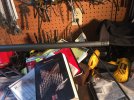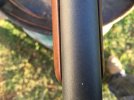I'd like to start an open minded HEALTHY discussion on barrel contour options - possibly to include carbon and fluting options.
I have several upcoming Sporter builds that I'd like to overthink the contour profiles to optimize the performance for a given weight. One is a Kimber 84M to be chambered in 6.5CM. The others are MRC actions to be 300 PRC. Stocks will be built to fit though too large a diameter profile could be a problem. Looking at light to maybe medium profile. Stocks will be English Walnut think Winchester Supergrade/Jerry Fisher/Echols, etc. style. So slender not a big flat forend.
I've read the test results on carbon vs fluted vs profile to weight, etc. I'll find and post some links. Everything of substance I see shows that barrel weight over other things largely determines performance.
My thoughts are to shape the straight shank length to match the shoulder of the cartridge and do a more aggressive taper to maximize the stiffness for a given weight while not getting too carried away as weight and appearance does matter.
Kimber 84M is 1.050" diameter straight shank 1.5" (Creedmoor shoulder length) with a standard 30" radius sporter arc to a diameter of about 0.810" tapering 0.012" per inch to 0.575" muzzle. I may run a Terminator T1 brake, 24" length.
MRC is 1.200" diameter straight shank 2.125" (300 PRC shoulder length) with a standard 30" radius sporter arc to a diameter of about 0.860" tapering 0.012" per inch to about 0.620" muzzle. I will run a Terminator T1+ or T2 brake 26" length
I'd like to try a Bartlein carbon but don't think it can get the wood stock to be right with that large a profile. I'm not really interested in fluting both appearance and past experience with fluted barrels. I don't think fluted gets a performance gained over equal weight tapered.
Thoughts and insights?
I have several upcoming Sporter builds that I'd like to overthink the contour profiles to optimize the performance for a given weight. One is a Kimber 84M to be chambered in 6.5CM. The others are MRC actions to be 300 PRC. Stocks will be built to fit though too large a diameter profile could be a problem. Looking at light to maybe medium profile. Stocks will be English Walnut think Winchester Supergrade/Jerry Fisher/Echols, etc. style. So slender not a big flat forend.
I've read the test results on carbon vs fluted vs profile to weight, etc. I'll find and post some links. Everything of substance I see shows that barrel weight over other things largely determines performance.
My thoughts are to shape the straight shank length to match the shoulder of the cartridge and do a more aggressive taper to maximize the stiffness for a given weight while not getting too carried away as weight and appearance does matter.
Kimber 84M is 1.050" diameter straight shank 1.5" (Creedmoor shoulder length) with a standard 30" radius sporter arc to a diameter of about 0.810" tapering 0.012" per inch to 0.575" muzzle. I may run a Terminator T1 brake, 24" length.
MRC is 1.200" diameter straight shank 2.125" (300 PRC shoulder length) with a standard 30" radius sporter arc to a diameter of about 0.860" tapering 0.012" per inch to about 0.620" muzzle. I will run a Terminator T1+ or T2 brake 26" length
I'd like to try a Bartlein carbon but don't think it can get the wood stock to be right with that large a profile. I'm not really interested in fluting both appearance and past experience with fluted barrels. I don't think fluted gets a performance gained over equal weight tapered.
Thoughts and insights?
Last edited:


